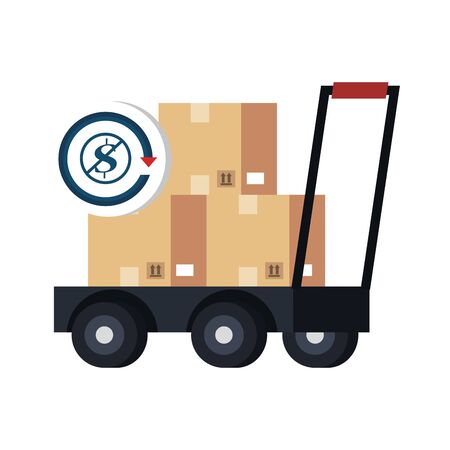Understanding US Shipping Options
If youre running an e-commerce business in the United States, getting shipping and fulfillment right can make or break your customer experience. With a huge country to cover and lots of choices available, its important to understand the main carriers, delivery methods, and regional considerations that affect how you get products to your customers.
Main Carriers in the US
When it comes to shipping in the US, three big players dominate:
| Carrier | Strengths | Best For |
|---|---|---|
| USPS (United States Postal Service) | Nationwide coverage, affordable rates for small/light packages, PO Box delivery | Small businesses, lightweight parcels, rural addresses |
| UPS (United Parcel Service) | Reliable tracking, fast delivery options, strong ground network | Larger/heavier packages, business-to-business (B2B) shipments |
| FedEx | Express services, international shipping expertise, late pickup times | Urgent deliveries, global shipments, time-sensitive orders |
Popular Delivery Methods
The way you ship your products affects both cost and customer satisfaction. Here are some common US shipping methods:
- Ground Shipping: Most affordable for domestic orders; takes a few days depending on distance.
- Two-Day & Next-Day Delivery: Premium options customers love for speed; higher cost but great for urgent orders.
- Flat Rate Shipping: Fixed price regardless of weight/distance; simplifies pricing for you and your customers.
- Local Delivery & Same-Day Delivery: Growing trend in cities; often handled by local couriers or gig economy services.
- P.O. Box Delivery: Only USPS delivers to PO Boxes—important if your customers use them.
Regional Considerations Unique to the US
The US is geographically diverse, so shipping isnt one-size-fits-all. Here are some key factors to keep in mind:
- Rural vs. Urban Areas: Rural deliveries can take longer and cost more. USPS often has better reach in remote locations.
- Alaska & Hawaii: Expect higher costs and longer transit times compared to the continental US. Not all carriers offer standard rates here.
- Puerto Rico & US Territories: Check carrier policies—some treat these as domestic while others charge international rates.
- Weather Impacts: Hurricanes, snowstorms, and wildfires can disrupt deliveries seasonally in certain regions.
- Major Cities: Traffic congestion may delay deliveries; consider local courier partnerships for faster service.
Your Next Steps: Choose Wisely!
The best shipping choice depends on your product size, customer location, budget, and delivery expectations. By understanding these core options and regional differences, youre ready to set up a shipping strategy that works for your US e-commerce business.
2. Setting Up Seamless Fulfillment Processes
Understanding Your Fulfillment Options
When running a US-based e-commerce business, getting your products to customers quickly and reliably is essential for building trust and loyalty. You have two main options for order fulfillment: handling everything in-house or partnering with a Third-Party Logistics (3PL) provider. Let’s break down the pros and cons of each so you can choose what fits your business best.
| Fulfillment Method | Pros | Cons |
|---|---|---|
| In-House Fulfillment | Full control over packing & shipping; Personal customer experience; Flexible for small order volumes | Time-consuming as you grow; Need warehouse space & staff; Harder to scale quickly |
| 3PL Partner | Scalable as you grow; Fast shipping from multiple locations; Less time spent on logistics | Less control over process; Monthly fees; Need strong communication with provider |
Simplifying Your Order Processing Workflow
No matter which route you choose, having a clear and streamlined order processing workflow is key. Here’s a simple step-by-step process most US e-commerce brands follow:
- Order Received: Customer places an order on your website.
- Order Verification: Automatically confirm payment and check for any issues (like out-of-stock items).
- Packing: Prepare the item(s) for shipment, making sure to use branded packaging if possible.
- Shipping Label Creation: Print shipping labels with carrier info (USPS, UPS, FedEx, etc.).
- Pick-Up/Drop-Off: Schedule carrier pick-up or drop off packages at a local hub.
- Status Update: Send tracking info to your customer right away.
- Inventory Adjustment: Automatically update inventory levels to reflect the sale.
Tip: Use Automation Tools!
E-commerce platforms like Shopify, WooCommerce, or BigCommerce often integrate with shipping software (like ShipStation or ShipBob). These tools automate steps like label printing and tracking emails, saving you time and reducing mistakes.
Ensuring Reliable Inventory Management
A seamless fulfillment process depends on having the right inventory available at all times. Here are some best practices for US entrepreneurs:
- Use Real-Time Inventory Tracking: Make sure your system updates stock levels instantly when orders are placed or received from suppliers.
- Set Reorder Points: Get alerts when stock is running low so you never sell out unexpectedly.
- Avoid Overstocking: Too much inventory ties up cash and increases storage costs—find a balance based on historical sales data.
- A/B Test Storage Locations: If using 3PLs with warehouses across the US, test which locations deliver fastest to your top markets.
- Regular Audits: Count physical inventory regularly to catch errors early and keep your records accurate.
Main Takeaway
The key to mastering fulfillment in the US e-commerce market is having a well-defined workflow—whether you’re packing boxes yourself or working with a logistics partner. Automate wherever you can, monitor your inventory closely, and always keep your customers updated along the way.

3. Navigating Shipping Costs, Pricing, and Free Shipping Strategies
Understanding Shipping Costs for US E-Commerce
Shipping costs can make or break your e-commerce business. In the US, customers expect fast and affordable shipping, so it’s crucial to get this part right. Here are some main factors that influence your shipping costs:
| Factor | Description |
|---|---|
| Package Size & Weight | Larger and heavier packages cost more to ship. Carriers like USPS, UPS, and FedEx use dimensional weight pricing. |
| Destination | Shipping zones affect price—the further the package travels from your location, the higher the cost. |
| Shipping Speed | Expedited options like 2-day or overnight delivery are pricier than standard ground shipping. |
| Carrier Selection | Different carriers offer different rates and discounts for business accounts. |
| Additional Services | Tracking, insurance, and signature confirmation add extra charges. |
Calculating Shipping Costs: Step-by-Step
- Weigh & Measure Your Package: Use a digital scale and measuring tape to get accurate dimensions.
- Select Your Carrier: Compare rates using online calculators provided by USPS, UPS, FedEx, or third-party tools like ShipStation or Pirate Ship.
- Consider Volume Discounts: As your order volume grows, negotiate better rates with carriers or use fulfillment services that offer bulk discounts.
- Add Packaging Materials: Don’t forget to include the cost of boxes, tape, labels, and packing materials in your calculations.
- Include Handling Fees (if needed): Factor in labor or time spent preparing orders if you want to recoup those costs.
Integrating Shipping Costs Into Your Pricing Model
Your product pricing needs to cover not just product costs but also shipping expenses. There are three common approaches:
| Approach | Description | Best For |
|---|---|---|
| Flat Rate Shipping | Charge a fixed amount regardless of order size or destination. | Simplifies checkout for most US-based orders. |
| Variable Rate Shipping | Charge customers the exact calculated shipping cost based on their location and cart contents. | If your products vary greatly in size/weight or you ship nationwide. |
| Free Shipping (Costs Included in Price) | Bake average shipping costs into product prices so customers see “free shipping” at checkout. | If you want to increase conversions and compete with major retailers like Amazon. |
Tip: Analyze Your Margins!
Always check how each method impacts your profit margins. Use spreadsheets or e-commerce platform reports to monitor profitability as you experiment with different strategies.
The Power of Free Shipping Offers
American shoppers love free shipping—it’s often a deciding factor when making a purchase. Here’s how you can leverage it to drive sales:
- Set a Minimum Order Value: Encourage larger purchases by offering free shipping on orders over a set amount (e.g., $50).
- Limited-Time Promotions: Run special free shipping weekends or holiday offers to boost conversion rates during slow periods.
- Select Specific Products: Offer free shipping only on bestsellers or high-margin items to balance out costs.
- Loyalty Perks: Reward repeat customers with exclusive free shipping deals through email lists or rewards programs.
Example: Free Shipping Threshold Table
| Total Order Amount | Shipping Fee Charged to Customer |
|---|---|
| $0–$49.99 | $6.95 Flat Rate |
| $50+ | $0 (Free Shipping) |
This approach motivates shoppers to add more items to their carts just to qualify for free shipping—a win-win for both you and your customers!
4. Handling Returns and Customer Expectations
Understanding US Consumer Expectations
US shoppers expect a smooth, transparent returns process when shopping online. They look for clear return windows, free or low-cost return shipping, and fast refunds. Many customers read return policies before purchasing and may abandon their carts if the policy seems too strict or confusing.
Key US Consumer Return Preferences
| Expectation | Details |
|---|---|
| Return Window | At least 30 days from delivery |
| Return Shipping | Free or discounted rates preferred |
| Refund Speed | Within 3-5 business days after receipt |
| Policy Clarity | Simple language, easy-to-find info |
| No Hassle Process | No questions asked for most items |
Designing Hassle-Free Return Policies
A hassle-free return policy is essential for building trust and encouraging first-time buyers. Make your policy easy to understand with step-by-step instructions and avoid hidden conditions. Offer printable labels or QR code returns if possible. Let customers track their return status online.
How to Make Returns Easy for Your Customers:
- Use plain English in your policy—avoid legal jargon.
- Create a dedicated “Returns & Exchanges” page on your website.
- Add a FAQ section addressing common return questions.
- If possible, offer free return shipping or share costs with prepaid labels.
- Email customers confirmation when their return is received and refunded.
- Clearly state which products are non-returnable (e.g., final sale, personalized items).
Using Returns to Build Customer Loyalty
A positive returns experience can turn a one-time shopper into a loyal customer. Quick refunds, polite communication, and flexible solutions show you care about customer satisfaction. Use returns as an opportunity to gather feedback—ask why the item was returned and use this information to improve products or descriptions.
Loyalty-Building Tips:
- Thank customers for their feedback on returns.
- Offer discounts or store credit for future purchases as a goodwill gesture.
- If someone had a bad experience, reach out personally to make it right.
- Track frequent return reasons to identify patterns and reduce future returns.
5. Staying Compliant and Preparing for Growth
Understanding US Shipping Regulations
Navigating US shipping regulations is a must for every e-commerce entrepreneur. These rules cover everything from labeling requirements to restricted items and carrier-specific guidelines. For example, shipping alcohol or hazardous materials comes with strict federal and state rules. Always check the latest guidelines with carriers like USPS, UPS, and FedEx, and consult resources from the Department of Transportation (DOT) or Federal Trade Commission (FTC).
Common US Shipping Rules Table
| Item Type | Key Regulation | Who Regulates? |
|---|---|---|
| Alcohol | State-by-state restrictions, age verification required | ATF, State Laws |
| Hazardous Materials | Special packaging & labeling, carrier approval | DOT, Carrier Guidelines |
| Certain Foods | FDA approved packaging & handling | FDA |
| Batteries (Lithium) | Packaging limits, warning labels | DOT, Carrier Guidelines |
Navigating Taxes for E-Commerce Shipping
E-commerce businesses in the US must pay attention to sales tax collection, especially after the Supreme Court’s South Dakota v. Wayfair decision. This means you may need to collect sales tax in states where you have customers—even if you don’t have a physical presence there.
Basic Sales Tax Responsibilities Table
| Action Needed | Description | Resource Link |
|---|---|---|
| Register for Sales Tax Permit | Apply in each state where you have nexus (connection) | TaxJar State Guides |
| Collect Sales Tax at Checkout | Add correct rate based on customer location (destination-based) | Avalara Sales Tax Rates Guide |
| File and Remit Collected Tax | Send payments and reports to each state as required (monthly/quarterly) | Sales Tax Institute Filing Dates |
Packing Laws and Sustainability Requirements
Packing laws are not just about protecting your products—they also help your business stay compliant. Some states require recycled content or specific labeling on packaging. California, for example, has strict rules about what can be labeled “recyclable.” Make sure your packaging suppliers meet these standards and keep updated on new environmental regulations.
Packing Law Quick Facts Table
| State/Area | Main Rule or Requirement |
|---|---|
| California | No false “recyclable” claims; minimum recycled content for some plastics |
| Maine/Oregon | EPR laws requiring producers to help fund recycling programs |
| US-wide | No hazardous materials in consumer packaging (lead, mercury) |
Scaling Fulfillment as Your Business Grows
If your order volume is growing fast, it’s time to upgrade your fulfillment process. You might start by fulfilling orders yourself but eventually need to use a third-party logistics (3PL) partner or open additional warehouse locations across the country.
Main Fulfillment Options Table
| Option | Main Benefit | Main Challenge | When to Consider? |
|---|---|---|---|
| In-House Fulfillment | Total control over packing & branding | Lack of scale; labor intensive | Early stage or niche products |
| Dropshipping | No inventory management needed | No control over shipping speed or quality | If testing new products or low volume |
| Third-Party Logistics (3PL) | Saves time; nationwide reach; faster shipping options | Adds cost; less hands-on control | If orders exceed 100+ per month or need 2-day delivery nationwide |
| Multi-Warehouse Network | Shorter delivery times; redundancy during busy seasons | Adds complexity; higher fixed costs | If scaling fast with consistent demand across the US |
Your Takeaway:
If you want to succeed in US e-commerce shipping and fulfillment, focus on staying compliant with regulations and taxes while also preparing your operations for growth. Keeping up with changing laws and expanding your fulfillment options will help you deliver faster, avoid penalties, and build customer trust as your business scales up.


